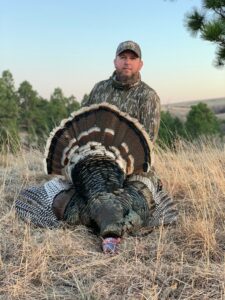No it’s not Thanksgiving, it’s just that other most wonderful time of the year, spring turkey season. If you have never been turkey hunting, let me fill you in on what all you’re missing. Now don’t let me fool you, harvesting a big gobbler is the icing on the cake, but spring is also a time of beautiful colors. The Blue Bonnets are in full bloom along with a multitude of other fragrant wild flowers. The mornings are typically nice and pleasant and give you an opportunity to enjoy countless songs of little birds waking up across the landscape, and if you’ve never heard that first thundering gobbler as he is waking up perched high up in a Live Oak tree, then you are certainly in for some shock and awe as the sun begins to show itself. There is just something peaceful about watching a spring-time sunrise, listening to the world wake up and it is nothing like those crisp cool fall mornings from a deer stand where you are often chilled to the bone and your only worry is how soon the sun will begin to warm you up.

After getting to experience the world wake up around you, it is time to get serious about bringing that gobbler into shotgun range. What many hunters don’t realize is that in the wild turkey world, the gobblers (a term used for a mature male turkey) use gobbling and strutting to attract hens to them, not the other way around. It is completely against their nature to want to come to you just because you are calling to them like a hen, but it works, and has been the demise of many love-sick toms. As these enormous birds carefully approach your location looking for that love struck hen, you are hopefully in a position to watch the show that will undoubtedly unfold in front of you.
To attract the hen to his location, the gobbler begins to increase his gobbling and puffs up into what is known as a strut. This is easy to recognize as he will look twice as big as normal with his tail feathers fanned out behind him, his chest jutting out, and wings dragging the ground. Seeing this is when you will most likely begin to feel your own heart start to beat out of your chest. As he dances towards you, he begins to spit and drum. This is caused by the male turkey forcing guttural air up through his body and is just another way to create noise and attract that hen to him. As he comes closer, you will also hear him scraping the ground with his outstretched wings. If you’ve ever harvested a spring turkey, you probably noticed his feathers on his wing tips were all ground flat. This is due to him dragging his wings on the ground while he struts. Whether you ever pull the trigger or not, this will be a moment that lives on forever and will most likely turn you into a turkey hunter for life.
As you move around your hunting area, it’s always smart to be on the look-out for turkey signs such as tracks and strutting zones. A great way to locate a strutting zone is to find sandy areas in open areas or along lease roads and look for turkey tracks accompanied by weird looking squiggly lines on both sides of the tracks. This is a great sign that a big gobbler is using the area to dance back and forth to try and attract the ladies. When you see this, just know you’re in the right area and it just might be a spot you want to sit down and start calling. Regardless of the sign or whether you ever harvested a big gobbler, I hope you take time to get out this spring and enjoy all the Texas spring has to offer. It won’t be long before the summer heat sets in and we will once again be dreaming of those cool crisp mornings listening to the world wake up around us.
And remember, if you get the chance, the turkey woods are a wonderful place to introduce that kiddo or neighbor down the street to hunting and conservation. Opportunities are often limited in Texas so don’t forget to ask them to go with you and show them what it’s all about!
By TJ Goodpasture
Director of Development, TWA Foundation.